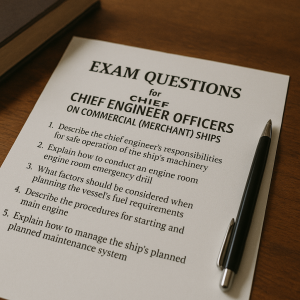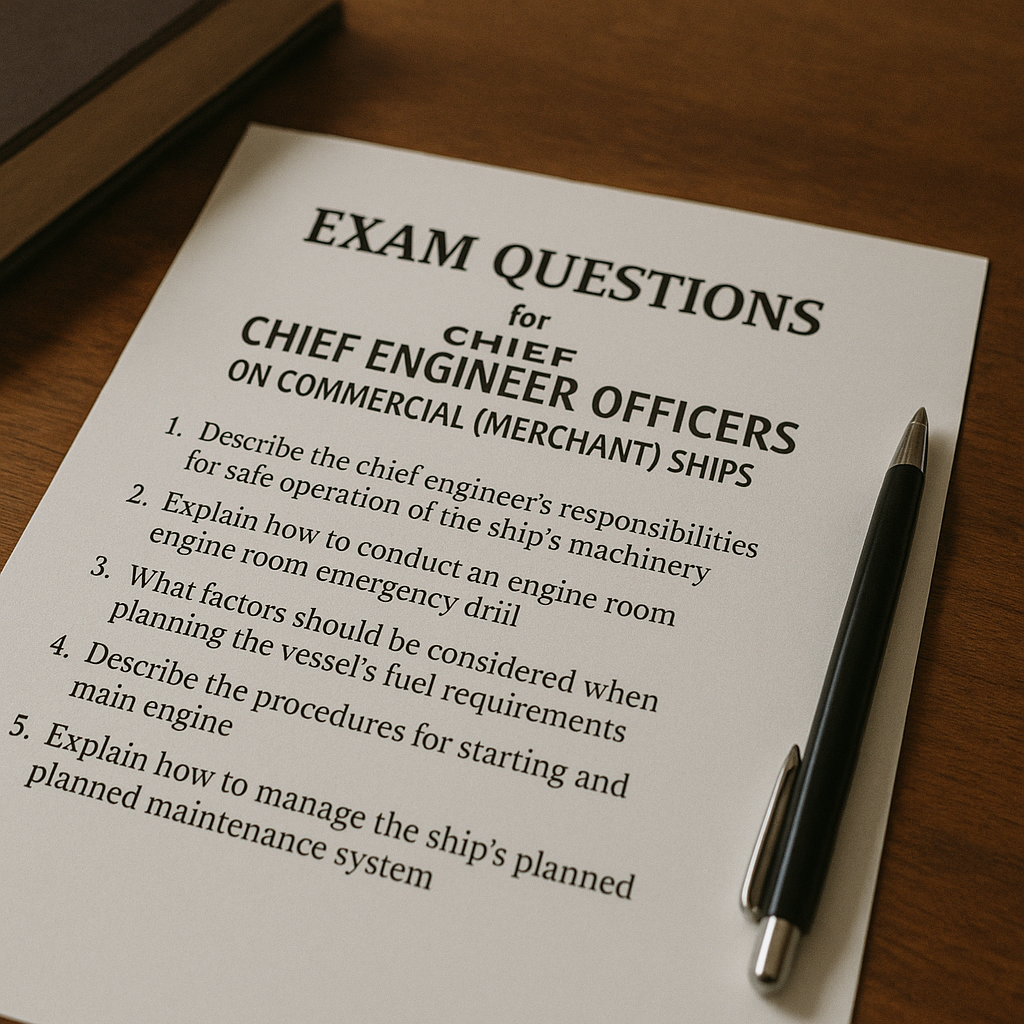Master your Chief Engineer Officer exams with confidence. Explore the top 40 exam questions asked globally for marine engineers on commercial ships—covering regulations, real-world challenges, and expert guidance.

Reaching the rank of Chief Engineer on a merchant vessel isn’t just a certification — it’s a command-level responsibility. The Chief Engineer leads the ship’s technical operations, ensuring propulsion, energy, safety, and environmental compliance are flawlessly executed. In a world where machinery downtime, pollution incidents, and audits are under constant scrutiny, a Chief Engineer must blend deep technical know-how with strategic decision-making.
Whether you’re preparing for UK MCA oral exams, Indian MEO Class I, AMSA certification, or Transport Canada assessments, this guide provides a globally aligned overview of the top 40 exam questions typically faced by candidates aiming for their Chief Engineer certificate of competency (CoC).
Why Chief Engineer Exams Matter in Modern Maritime Operations
The role of Chief Engineer has evolved beyond engine maintenance. According to the International Maritime Organization (IMO) and BIMCO/ICS Seafarer Workforce Report, Chief Engineers are now frontline leaders for:
- Decarbonisation (EEXI/CII compliance)
- Digitalisation (automation, engine monitoring systems, predictive maintenance)
- Port State Control compliance
- Cybersecurity and risk management
- Crew leadership and training
With nearly 90% of mechanical failures at sea attributed to human error (source: Lloyd’s List Intelligence), the exam ensures Chief Engineers possess the competence to operate safely, sustainably, and efficiently.
Core Competency Areas with Sample Questions
Marine Propulsion and Main Engine Systems
- Describe the procedures for starting, running, and stopping a MAN B&W ME-C engine.
- Include critical interlocks, cylinder lubrication control, jacket water preheating, and bridge coordination.
- What causes high exhaust gas temperatures in a single unit, and how do you respond?
- Possible causes: injector fault, turbocharger fouling, piston ring leakage.
- How do you handle a scavenge fire in a two-stroke engine?
- Immediate slowdown or stop, activate fixed firefighting system, monitor crankcase temps, ventilate post-extinction.
- What is the function of an exhaust gas economiser, and what maintenance does it require?
- Recovers heat for steam generation; check for soot fire risk, clean regularly.
- What are the advantages of electronically controlled engines?
- Better fuel control, lower NOx, flexible timing, integration with ship automation.
Auxiliary Machinery and Power Generation
- Explain parallel operation of generators and load sharing methods.
- Manual vs. automatic synchronising, droop settings, reactive power sharing.
- What are the standard checks before starting an auxiliary engine?
- Fuel, lube oil, jacket water, air filters, pre-lubrication, crankcase inspection.
- How does a shaft generator system integrate with shipboard power?
- PTO/PTH modes, load sharing with AE, grid frequency stabilisation.
- Describe the blackout recovery sequence in a modern engine room.
- Emergency generator kicks in, critical loads prioritised, manual or auto restoration of main bus.
- How do you identify and mitigate torsional vibration in propulsion shafts?
- Measure using torsiograph; fit dampers, tune speed ranges.
Boilers, Steam Systems, and Thermal Efficiency
- What is the difference between smoke tube and water tube boilers?
- Smoke tube for low pressure; water tube for higher efficiency and pressure.
- Explain the importance of blowdown and boiler water tests.
- Controls conductivity, prevents scaling/corrosion. Regular sample testing required.
- What are boiler safety interlocks, and how are they tested?
- Low water level trips, flame failure interlocks, feedwater control valves.
- Describe an energy-saving measure involving waste heat recovery.
- Economisers and composite boilers; MARPOL compliance via reduced fuel use.
- What is meant by boiler ‘carryover’?
- Water entrained in steam; causes turbine blade damage and poor quality steam.
Pollution Control and Environmental Compliance
- Explain the Chief Engineer’s responsibilities under MARPOL Annex I.
- OWS oversight, ORB maintenance, sludge management, oil transfer protocols.
- What is the use of EGA (Exhaust Gas Analyzer) in SOx monitoring?
- Measures SO₂/CO₂ ratio; verifies compliance with 0.5% sulphur fuel rule (or 0.1% in ECAs).
- Describe how the CII rating system affects engine operations.
- Requires efficient fuel usage, voyage planning, possible derating or retrofits.
- How do you comply with ballast water exchange requirements?
- Use of treatment systems or exchange 200nm offshore; maintain Ballast Water Record Book.
- What are the maintenance needs of a marine scrubber system?
- SOx washwater pumps, pH sensors, sludge tank management, corrosion checks.
Safety, Risk Management, and Emergency Response
- What procedures follow a crankcase explosion?
- Secure engine, assess for fire, vent gases, check oil mist detector logs, initiate investigation.
- How do you conduct a root cause analysis after a machinery failure?
- Collect evidence, apply 5 Whys, consult manuals, verify with data loggers.
- Describe the testing routine for fixed fire-fighting systems.
- Weekly CO₂ bottle pressure check, valve exercise, crew training and simulations.
- What is the Chief Engineer’s duty during abandon ship?
- Secure engines, shut down systems, muster and verify engineering crew, carry SOPEP box.
- How do you manage confined space entry for a deep tank inspection?
- Enforce permit-to-work, atmosphere testing, rescue plan, standby personnel.
Leadership, Audit Readiness, and Crew Management
- How do you prepare for a third-party Class survey or audit?
- Document check, maintenance logs, training records, physical equipment readiness.
- What is the purpose of the Planned Maintenance System (PMS)?
- Ensures timely servicing; mandated by ISM Code, improves reliability, reduces unscheduled breakdowns.
- Describe your approach to mentoring junior engineers.
- Provide clear expectations, involve in maintenance, review logbooks, explain safety culture.
- What documentation is reviewed during Port State Control?
- Class certificates, IOPP, SMC, Oil Record Book, PMS records, training drills.
- How do you handle disciplinary issues within the engine department?
- Listen, document, resolve onboard if possible, report to Master, follow MLC grievance protocol.
Ship Systems Automation and Digital Technologies
- What are the benefits and risks of unmanned engine rooms (UMS)?
- Benefits: lower manning cost, efficiency. Risks: delayed response, false alarms, sensor failure.
- How do you validate alarm system reliability?
- Functional tests, false alarm tracking, alarm prioritisation audits.
- Describe the working of an Integrated Control and Monitoring System (ICMS).
- Centralises monitoring (power, propulsion, safety), integrates with PMS and diagnostics.
- What is predictive maintenance and how is it applied?
- Uses sensor data and analytics to forecast equipment failure; examples: bearing vibration.
- Explain cybersecurity risks related to engine room automation.
- PLC hacking, malware in control systems; mitigated by firewalls, air-gapped networks, updates.
Technical Documentation and Legal Obligations
- How do you ensure correct entries in the Oil Record Book (ORB)?
- Follow MARPOL format, sign entries, crosscheck with tank sounding log.
- What is the significance of the Inventory of Hazardous Materials (IHM)?
- Part of EU Ship Recycling Regulation; lists hazardous materials onboard.
- Describe the chain of reporting in case of a pollution incident.
- Chief to Master, then to DPA, followed by Coastal Authority, as per SOPEP.
- What are the legal risks of falsifying technical records?
- PSC detention, personal fines, criminal charges under IMO and national laws.
- What are the IACS recommendations for machinery space design?
- Access, ventilation, alarm system redundancy, escape routes, fire protection standards.
Case Studies and Real-World Lessons
In a 2022 MAIB report, a container vessel lost propulsion due to incorrect calibration of a main engine safety override. The root cause? Miscommunication between the 2nd and Chief Engineer. The vessel was detained for three days in Antwerp.
Similarly, an AMSA detention in 2021 revealed falsified ORB entries and a malfunctioning OWS bypass valve. The Chief Engineer faced both fines and suspension. These real-life cases show that beyond technical knowledge, ethics and leadership define success at this level.
FAQ
What is the passing rate for Chief Engineer orals globally?
Usually 65–80%, depending on country. Preparation, mock sessions, and simulator use help.
Can I carry reference material during the oral exam?
Generally no, but knowing manufacturer standards and quoting IMO/ISM helps.
Is simulator assessment mandatory?
Yes, many flags (UK, Canada, Australia) require bridge and engine simulator evaluations.
How long should I prepare for orals?
2–4 months is common, with daily revision, mock assessments, and case study analysis.
Do questions vary significantly between countries?
Content is similar globally, as all follow STCW Regulation III/2 — differences lie in format.
Conclusion
Becoming a Chief Engineer is about more than operating the main engine — it’s about commanding respect, ensuring compliance, guiding your team, and protecting lives and the environment. These 40 questions are not just for examiners to ask — they are for you to live and lead by.
As the machinery becomes smarter and the world expects more from shipping, today’s Chief Engineers must be both technically brilliant and ethically sound.
Study with commitment, lead with clarity, and pass with pride.
References
- STCW Convention (https://www.imo.org/en/About/Conventions/Pages/STCW-Convention.aspx)
- MARPOL Annex I & VI (https://www.imo.org/en/OurWork/Environment/Pages/Default.aspx)
- ISM Code (https://www.imo.org/en/OurWork/Safety/Pages/ISMCode.aspx)
- IACS Recommendations (https://www.iacs.org.uk)
- MAIB Investigation Reports (https://www.gov.uk/maib-reports)
- Alfa Laval Systems (https://www.alfalaval.com)
- Wärtsilä Technical Documentation (https://www.wartsila.com)
- Marine Insight (https://www.marineinsight.com)
- IMAREST (https://www.imarest.org)
- Lloyd’s Register and DNV (https://www.lr.org, https://www.dnv.com)
- EU Ship Recycling Regulation (https://environment.ec.europa.eu)
- Transport Canada Marine Safety (https://tc.canada.ca/en/services/marine)
- The Nautical Institute (https://www.nautinst.org)
- OCIMF Guidelines (https://www.ocimf.org)
- Marine Pollution Bulletin (Elsevier)
- BIMCO/ICS Seafarer Workforce Report (https://www.ics-shipping.org/publication/seafarer-workforce-report-2021/)
- IMO Model Course 7.02 (Chief Engineer on Ships Powered by Main Propulsion Machinery of 3,000 kW or More)


Comprehensive and helpful guide, thanks!